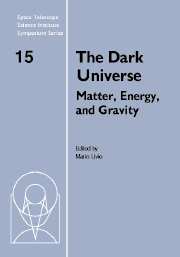Book contents
- Frontmatter
- Contents
- Participants
- Preface
- A brief history of dark matter
- Microlensing towards the Magellanic Clouds: Nature of the lenses and implications on dark matter
- Searching for the Galactic dark matter
- Hot gas in clusters of galaxies and ΩM
- Tracking the baryon density from the Big Bang to the present
- Modified Newtonian Dynamics and its implications
- Cosmological parameters and quintessence from radio galaxies
- The mass density of the Universe
- Growth of structure in the Universe
- Cosmological implications of the most distant supernova (known)
- Dynamical probes of the Halo Mass Function
- Detection of gravitational waves from inflation
- Cosmological constant problems and their solutions
- Dark matter and dark energy: A physicist's perspective
Dark matter and dark energy: A physicist's perspective
Published online by Cambridge University Press: 21 August 2009
- Frontmatter
- Contents
- Participants
- Preface
- A brief history of dark matter
- Microlensing towards the Magellanic Clouds: Nature of the lenses and implications on dark matter
- Searching for the Galactic dark matter
- Hot gas in clusters of galaxies and ΩM
- Tracking the baryon density from the Big Bang to the present
- Modified Newtonian Dynamics and its implications
- Cosmological parameters and quintessence from radio galaxies
- The mass density of the Universe
- Growth of structure in the Universe
- Cosmological implications of the most distant supernova (known)
- Dynamical probes of the Halo Mass Function
- Detection of gravitational waves from inflation
- Cosmological constant problems and their solutions
- Dark matter and dark energy: A physicist's perspective
Summary
For physicists, recent developments in astrophysics and cosmology present exciting challenges. We are conducting “experiments” in energy regimes some of which will be probed by accelerators in the near future, and others which are inevitably the subject of more speculative theoretical investigations. Dark matter is an area where we have hope of making discoveries both with accelerator experiments and dedicated searches. Inflation and dark energy lie in regimes where presently our only hope for a fundamental understanding lies in string theory.
Introduction
It is a truism that the development of astronomy, astrophysics, cosmology relies on our understanding of the relevant laws of physics. It is thus no surprise that my astronomy colleagues tend to know more classical mechanics, electricity and magnetism, atomic and nuclear physics than my colleagues in particle theory.
As we consider many of the questions which we now face in cosmology, we must confront the fact that we simply do not know the relevant laws of nature. The public often asks us “What came before the Big Bang?” We usually think of this as requiring understanding of physics at the Planck scale. But at present we can't even come close. Ignorance sets in slightly above nucleosynthesis, and becomes severe by the time we reach the weak scale. Some of the questions which trouble us will be settled by experiment over the next decades; some require new theoretical developments. Needless to say, it is possible that much will remain obscure for a long time.
- Type
- Chapter
- Information
- The Dark UniverseMatter, Energy and Gravity, pp. 183 - 193Publisher: Cambridge University PressPrint publication year: 2004

